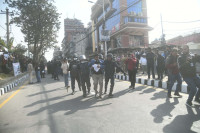Opinion
Long, long road
The government’s focus on connectivity rather than safety has made our roads unsafe
Ashish Gajurel
Roads facilitate the movement of people and materials. But if they are not maintained properly, they not just hamper the normal flow of transport but also pose risks to travellers. Roads pose a significant risk even during normal times. According to the World Health Organisation (WHO), road accident is the world’s eighth leading cause of death. Among young people aged 15-29, traffic accidents are the number one killer. Every 30 seconds, someone somewhere dies in a road crash and 10 are seriously injured. These figures get worse in the aftermath of disasters like earthquakes and landslides. Therefore, every country should prepare itself to manage traffic movements after such unforeseen events.
No strategy
As of now, sadly speaking, Nepal has no specific strategy to manage traffic movements after disasters. Worse still, our roads did not fare well during the disaster. The fact that our government encouraged people to return to their villages in the immediate aftermath of the earthquake, even without a thorough assessment of the highways snaking out of the Valley, shows the lack of proper planning and vision. Hence, despite the devastating quakes, people have been travelling at their own risks. In the Kathmandu Valley, for example, the road that links Koteshwor to Surayabinayak, which was built by the Japan International Cooperation Agency (JICA), has been severely damaged, especially the part between Lokanthali and Kaushaltar. Likewise, the Sindhuli-Banepa BP Highway has also been damaged. It has been marred with cracks and blocked by landslides and rock falls at several places. There were landslides at different locations on Tribhuvan and Trishuli highways. Similarly, the Barabise-Tatopani section of the Araniko Highway has also been badly damaged by the earthquake; while the Prithvi Highway, which has had extensive landslides in the past, has also experienced landslides problems since the earthquake, including large boulders falling onto the road.
Most of the roads in Nepal run through hilly areas. This means that in the event of a quake, which makes the land beneath the road unstable, they are highly vulnerable to rock falls and landslides. In addition, Nepali roads are narrow, have sharp curves, high gradient, steep slopes, unstable geographic features and only few sections with side bars, all of which add to the problem.
Despite understanding all these, our government encouraged more people to leave the Valley. As a result, many vehicles were buried and many people died in the affected parts of the highways.
Look to Japan
For our roads and other public infrastructures to become safe, our mindset regarding these infrastructures should change immediately. Currently, Nepal focuses on building new roads to enhance connectivity rather than building safer roads. So the emphasis is on numbers, not safety. Now that we have seen such a big disaster unfold right in front of us, safety should be the first priority.
According to the Japan Society of Civil Engineers, in Japan, two types of earthquake motions are considered in assessing the seismic capacity of civil engineering structures. Level one earthquake motions are those that do not damage structures when they occur. And level two earthquakes are those that are very strong and which put the structure’s quake-resistant abilities to test. In order to make its infrastructures (including roads) safer and more resilient, the Japanese government has divided the country into various geographic areas based on, among others, earthquake level occurrence possibility and has built infrastructures accordingly.
The same thing can be done in Nepal. By categorising different parts of the country into different levels, depending on the level of harm that could be caused by an earthquake, and building infrastructures accordingly, we can mitigate the harm that a possible disaster can do. We should realise now that although disasters are unavoidable, we have ways in our disposal to save as many lives as possible. A thorough analysis of soil and rock samples from throughout the country could form the basis of such a classification.
Rescue the roads
The other safety measure that we can take is building emergency lanes on the side of the road that could be used during disasters. Till date, the only road section in Nepal to have this kind of dedicated lane is the Bhaktapur road section of the Arniko Highway, extending from Koteshwor to Suryabinayak.
Besides infrastructure improvements, a good technical road assessment team should be formed at the concerned ministry. The team should be deployed for road assessment after any hazard and the opening and closing of roads should be determined as per their assessment. This will enable taking immediate action after any disaster with respect to the transportation system.
And unlike what we did during the recent quakes, no movement should be allowed on roads before inspection by the assessment team in the aftermath of a major disaster. The authority must be empowered to inspect road condition and take necessary action immediately while also informing the public .
Roads are vital arteries in the aftermath of any disaster. If they do not operate properly, they can bring rescue and relief efforts to a halt. So, it is important that we started paying attention to this infrastructure. Further, since the country has only one international airport, it is important that took these networks crisscrossing the country more seriously. In case the airport becomes dysfunctional, its only roads we have to maintain touch with the world outside.
Gajurel is a traffic engineer ([email protected])




 6.12°C Kathmandu
6.12°C Kathmandu










